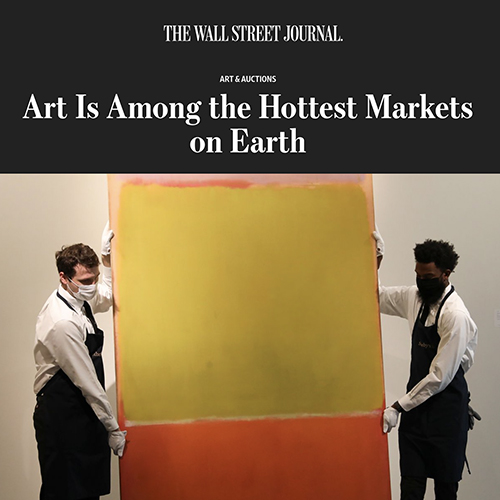Heather James has received many questions regarding the art market’s performance during volatile economic cycles. To respond, we are happy to share this video of gallery co-founder Jim Carona offering his in-depth analysis on the topic. Looking at the art market’s resilience during the 2008-2009 recession, we present our key observations as to why the art market has proven to be more resilient than other assets.

All-Art Index Chart showcases pre-recession high to recession low to post-recession bounce back from 2008-2010
- In recessionary periods, the art market has been the last to decline and first to recover. We saw this during the global financial crisis of 2008-09.
- While the S&P began declining in mid-2007, the all-art index did not trend down until late 2008.
- At its lowest point, the art market saw a 19.3% decrease from pre-recession highs, while the S&P saw a 47.7% decrease. The S&P 500 took four years to return to its pre-recession high from the low point, and this bounce-back occurred in under a year for the art market.
- Measured from the pre-recession highs, the art market took just 20 months to regain, while the S&P 500 took 5.5 years.
- Collectors have historically held onto their artwork during recessionary periods, further contracting supply and often leading to a high-demand situation.
- In February 2009, while traditional financial markets remained down, the hugely successful Yves Saint Laurent sale at Christie’s totaled nearly $484 million, setting the record as the most expensive private collection at auction. 95.5% of all lots sold.

S&P 500 Index Chart showcases pre-recession high to recession low to post-recession bounce back from 2007-2012

- In the early 2000s, the art market experienced a much milder recession than the financial markets. The peak to trough decline of the S&P 500 was 49.1%, whereas the all-art index only declined 18.82%.
- Fine art has a low correlation of 0.12 to the stock market, partially accounting for the strength of the art market during economic turmoil.

Source: Citi Private Bank Global Asset Allocation Team, as of October 31, 2020. Correlations are measured on a scale of 1 to -1, where 1 = two asset classes move in the same direction all of the time, -1 = two asset classes move in the opposite direction to each other all the time. Art represented by the Masterworks.io Total Art, Contemporary Art and Impressionist Art Indices. 2020 Masterworks.io LLC; All rights reserved. Indices revised as of November 2020.
In closing, we do not expect that the blue chip markets for top artists like Claude Monet and Vincent van Gogh will be significantly discounted in this time of economic uncertainty.
“When our market slows down, fewer things become available to sell, but anyone waiting around to get a 30% discount on a masterpiece may be disappointed and frustrated. We’re kind of like the oceanfront property that everyone’s waiting for the right moment to buy, but there’s a lot of money waiting for that moment. As soon as the price for anything goes down even a little bit, people start to jump in.” – Charles Stewart, CEO of Sotheby’s
Heather James Fine Art is not a registered investment, legal or tax advisor. All investment and financial opinions expressed by Heather James Fine Art are opinion based on personal research. Past performance is not a guarantee of future return, nor is it necessarily indicative of future performance.








